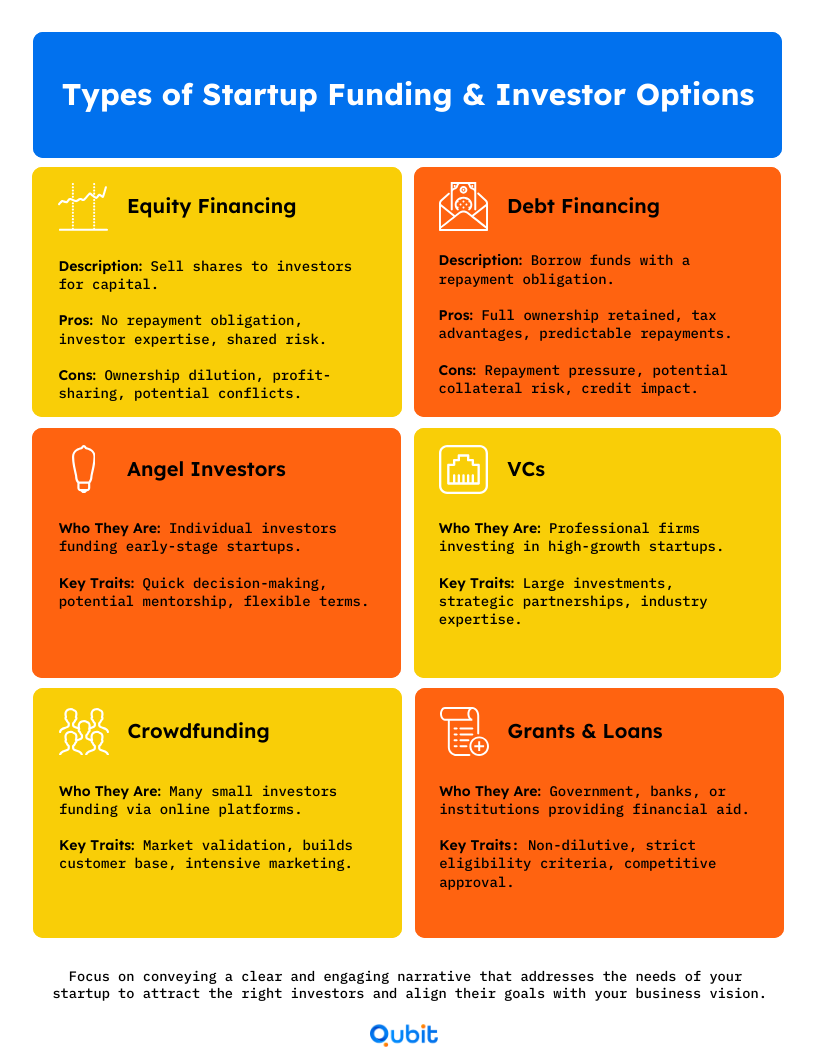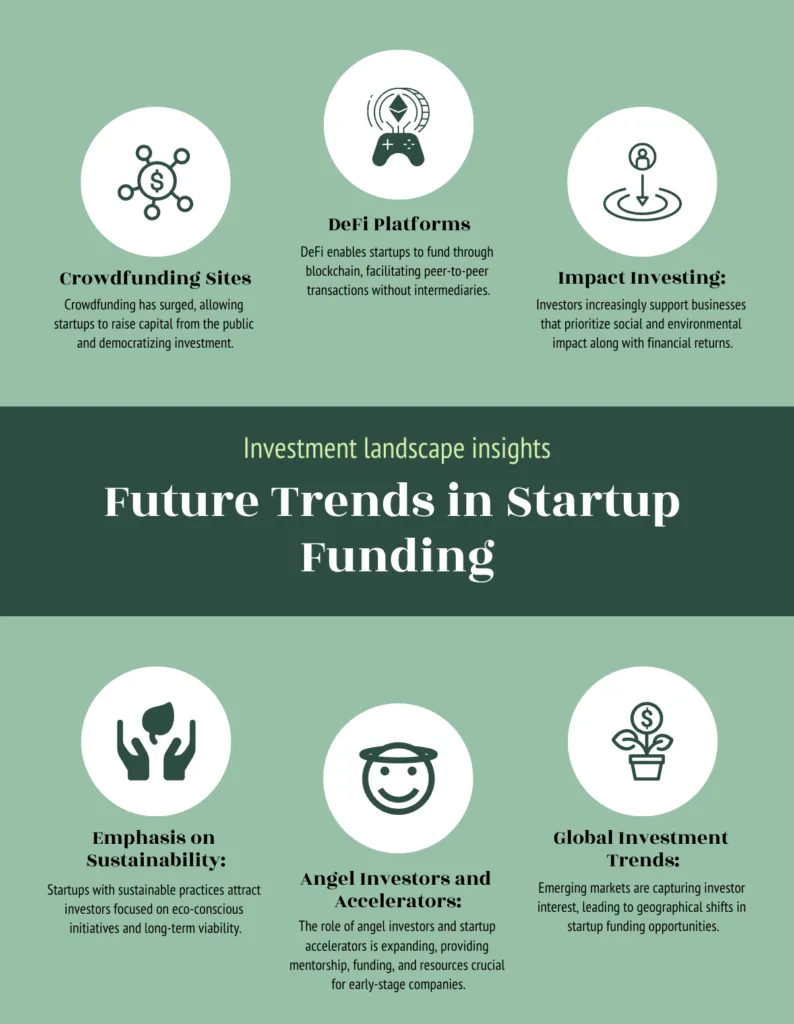Securing funding transforms your startup vision into reality. Without capital, even groundbreaking ideas can stall.
This guide offers essential strategies and practical tools to traverse the fundraising territory effectively.
Whether you're launching your first venture or looking to scale an existing business, we'll equip you with the knowledge to secure the funding your startup needs.
From grasping investor psychology to crafting compelling pitches and avoiding common pitfalls, you'll find actionable insights to propel your fundraising efforts.
These fundraising fundamentals and proven methods will not only show how to raise capital for your startup but also how to build lasting relationships with investors.
Let’s set your venture on the path to success!
Understanding Different Types of Funding and Investors

Equity Financing vs. Debt Financing
When exploring how to raise capital for your startup, understand the two primary financing methods: equity financing and debt financing. Each option offers distinct advantages and challenges, and choosing the right one depends on your startup's unique needs and goals.
Equity Financing
Equity financing involves raising capital by selling shares of your company to investors. In return, these investors receive ownership stakes, aligning their success with yours.
Benefits:
- No Repayment Obligation: Unlike loans, you aren't required to repay the investment with interest.
- Access to Expertise: Investors often bring valuable industry experience, networks, and mentorship.
- Shared Risk: Investors share both the risks and rewards of the business.
Considerations:
- Dilution of Ownership: Selling shares reduces your percentage of ownership and control.
- Potential Conflicts: Differences in vision between founders and investors can lead to disagreements.
- Profit Sharing: Future profits are shared with investors proportionally.
Debt Financing
Debt financing involves borrowing money that must be repaid over time, usually with interest. This can come from banks, financial institutions, or personal loans.
Benefits:
- Full Ownership Retained: You maintain complete control without diluting equity.
- Tax Advantages: Interest payments may be tax-deductible.
- Predictable Repayments: Fixed repayment schedules aid in financial planning.
Considerations:
- Repayment Pressure: Obligatory payments can strain cash flow, especially for early-stage startups.
- Collateral Requirements: Lenders may require assets as security, putting them at risk.
- Credit Impact: Failure to repay can damage your credit rating.
Real-Life Examples
Case Study 1: Tech Innovators Inc.
Tech Innovators Inc., an early-stage tech startup, chose equity financing by partnering with angel investors. These investors provided not only capital but also mentorship and industry connections. With their support, Tech Innovators accelerated product development and successfully launched their minimum viable product (MVP), attracting further investment.
Case Study 2: GreenThumb Solutions
GreenThumb Solutions, specializing in sustainable agriculture technology, opted for debt financing through a low-interest loan from a community bank. By retaining full ownership, they steered the company's vision independently. The loan facilitated essential equipment purchases, leading to increased production and profitability.
Types of Investors
Understanding the various types of investors helps you target the right sources of capital and tailor your approach effectively.
Angel Investors
Angel investors are affluent individuals who invest their personal funds in startups in exchange for equity. They're often involved in the early stages when risk is highest.
- Investor Motivation: Driven by the potential for high returns and the excitement of nurturing innovative ideas.
- Engagement Level: May offer mentorship and expect significant involvement in decision-making.
- Example: Jane Doe, a successful entrepreneur turned angel investor, focuses on tech startups revolutionizing healthcare.
Venture Capitalists (VCs)
Venture capitalists invest pooled funds from various sources into startups with high growth potential, usually at later stages than angels.
- Investor Motivation: Seek scalable businesses that can disrupt markets and provide substantial returns.
- Engagement Level: Expect rigorous due diligence, professional presentations, and clear exit strategies.
- Example: Alpha Ventures invests in fintech startups with proven traction and scalable models.
Crowdfunding Platforms
Crowdfunding allows entrepreneurs to raise small amounts of capital from a large number of people via online platforms.
- Investor Motivation: Backers are often customers interested in the product or mission rather than financial returns.
- Engagement Level: Success relies on effective storytelling and marketing to engage supporters.
- Example: Pebble Technology raised over $10 million on Kickstarter to develop their smartwatch.
Grants and Loans
Grants and loans are funds provided by governments, nonprofits, or institutions, often with favorable terms or specific targets.
- Investor Motivation: Aim to support industries or initiatives aligning with their missions, such as innovation or social impact.
- Engagement Level: Require adherence to application criteria and reporting requirements.
- Example: Small Business Innovation Research (SBIR) grants support R&D in tech startups.
Pros and Cons of Each Funding Type
Angel Investors
- Pros: Quick decision-making, potential mentorship, flexible terms.
- Cons: Limited capital amounts, possible significant equity loss, varying involvement levels.
Venture Capitalists
- Pros: Access to substantial funding, strategic partnerships, industry expertise.
- Cons: Reduced control over decisions, pressure for rapid growth, rigorous expectations.
Crowdfunding
- Pros: Market validation, builds customer base, no equity dilution (if rewards-based).
- Cons: Intensive marketing required, potential idea exposure, platform fees.
Grants and Loans
- Pros: Non-dilutive capital, favorable interest rates, credibility boosts.
- Cons: Competitive applications, stringent compliance, usage restrictions.
Explore Different Funding Options
Choosing the right funding type depends on your startup's stage, industry, and goals. For a deeper dive into various options, read our article on exploring different funding options.
Advanced Fundraising Strategies
To optimize your fundraising efforts, delve into our guide on advanced fundraising strategies for startups, offering cutting-edge techniques and actionable insights.
Stages of Startup Funding
As your startup grows, its funding needs evolve. Familiarizing yourself with the typical funding stages helps you target appropriate investors and tailor your pitches.
Overview of Funding Stages
- Pre-Seed Stage
- Purpose: Validate the idea, develop a prototype.
- Funding Sources: Personal savings, friends and family, small grants.
- Seed Stage
- Purpose: Develop the MVP, conduct market research, refine the business model.
- Funding Sources: Angel investors, seed funds, crowdfunding.
- Series A
- Purpose: Optimize the product, expand the user base, generate revenue.
- Funding Sources: Venture capital firms, strategic investors.
- Series B and Beyond
- Purpose: Scale operations, enter new markets, increase market share.
- Funding Sources: Larger VCs, private equity, corporate investors.
- Late-Stage Funding
- Purpose: Prepare for IPO or acquisition, achieve market dominance.
- Funding Sources: Institutional investors, hedge funds, mezzanine financing.
Key Considerations
- Align Funding with Milestones: Each round should correspond to specific business achievements.
- Investor Expectations Increase: Later stages demand more proof of traction and scalability.
- Impact on Valuation: Funding stages influence company valuation and ownership dilution.
Internal Link
For detailed strategies at each funding stage, visit our guide on funding stages from Seed to Series C and beyond.
Preparing for Fundraising
Successful fundraising requires meticulous preparation. By understanding your capital needs and refining your presentation, you enhance your chances of attracting the right investors.
Determining Capital Needs
Accurately assessing how much capital to raise is crucial. Overestimating can lead to unnecessary dilution, while underestimating may hinder your startup's progress.
Steps to Calculate Capital Needs:
- Project Expenses
- Operational Costs: Salaries, rent, utilities.
- Capital Expenditures: Equipment, technology infrastructure.
- Marketing and Sales: Advertising, promotions.
- Estimate Revenues
- Use market data to forecast sales based on realistic assumptions.
- Calculate Burn Rate
- Determine how quickly you'll spend capital before achieving positive cash flow.
- Set Milestones
- Define short-term and long-term goals aligned with your business plan.
- Include a Buffer
- Allocate funds for unforeseen expenses or delays.
Financial Tools
Utilize our customizable financial projection sheets to create accurate forecasts.
Building a Compelling Pitch Deck
Your pitch deck is often the first impression investors have of your startup. It must be engaging, concise, and tailored to your audience.
Essential Elements:
- Executive Summary: Brief overview of your business.
- Problem Statement: Define the problem your startup solves.
- Solution Overview: Present your unique value proposition.
- Market Analysis: Highlight market size and target customers.
- Business Model: Explain revenue generation and pricing strategies.
- Traction and Milestones: Share achievements and growth metrics.
- Team Introduction: Showcase your team's expertise.
- Financials: Provide projections and funding needs.
- Competitive Landscape: Articulate your differentiators.
- The Ask: Clearly state your funding requirements.
Personalization Strategies
- Align with Investor Interests: Research investors and tailor your pitch accordingly.
- Understand Cultural Nuances: Be mindful of international business etiquette.
- Tell a Story: Craft a narrative that resonates emotionally and logically.
Within-Cluster Link
For tips on crafting effective pitch decks, read our article on top fundraising tools for startups.
Financial Projections and Business Plans
Robust financial projections and a solid business plan establish credibility with investors.
Importance:
- Demonstrates Viability: Shows thorough research and planning.
- Supports Valuation: Justifies your funding request.
- Clarifies Needs: Explains how funds will be used.
Available Templates:
- Financial Projection Sheets: Income statements, cash flow statements, balance sheets.
- Business Plan Templates: Market analysis, organizational structure, marketing strategies.
Downloadable Resources
Access our comprehensive financial projection sheets and business plan templates to streamline your preparation.
Legal Considerations and Consulting Professionals
Navigating legal requirements is critical to protect your startup and ensure compliance.
Key Areas:
- Corporate Structure: Choose the appropriate entity (e.g., LLC, C-Corp).
- Regulatory Compliance: Understand securities laws and industry regulations.
- Intellectual Property: Protect your innovations with patents and trademarks.
Professional Guidance
- Legal Experts: Assist with agreements and compliance.
- Financial Advisors: Offer insights on valuation and structuring.
- Accountants: Ensure accurate reporting and tax compliance.
Cross-Cluster Link
For detailed legal guidance, read our article on legal aspects of fundraising.
Attracting Investors and Managing Relationships
Building strong relationships with investors is as important as securing initial capital. Effective networking, personalization, and communication make a significant difference.
Networking Strategies
A robust professional network increases your visibility to potential investors.
Techniques:
- Attend Industry Events: Participate in conferences and pitch competitions.
- Leverage Online Platforms: Use LinkedIn and industry forums to connect.
- Join Incubators and Accelerators: Gain mentorship and investor access.
- Engage in Community Initiatives: Involve yourself in local startup ecosystems.
Example:
Sarah, founder of an edtech startup, secured funding after presenting at a local entrepreneur meetup, catching the eye of an angel investor passionate about education.
Personalization Techniques for Investor Engagement
A personalized approach demonstrates genuine interest and increases investment likelihood.
Tips:
- Research Investor Profiles: Understand their investment history and interests.
- Customize Communication: Tailor pitches to address specific goals.
- Build Authentic Relationships: Focus on meaningful interactions.
- Respect Cultural Nuances: Be aware of international business etiquette.
Understanding Investor Psychology
Grasping what drives investor decisions allows you to position your startup effectively.
Key Motivations:
- Risk vs. Reward: Investors assess potential returns against risks.
- Market Potential: A growing market enhances attractiveness.
- Team Confidence: A competent team inspires trust.
- Innovation: Unique solutions stand out.
Strategies:
- Highlight Scalability: Emphasize growth potential.
- Demonstrate Traction: Show user adoption and partnerships.
- Provide Social Proof: Share endorsements and press coverage.
Within-Cluster Link
Explore more in our article on proven strategies for obtaining startup funding.
Negotiating Terms and Deal Structuring
Negotiating favorable terms is crucial. Being prepared enhances your position.
Advice:
- Know Your Startup: Understand your valuation and acceptable terms.
- Understand Common Terms:
- Equity Stakes: Percentage ownership offered.
- Liquidation Preferences: Rights during liquidation events.
- Vesting Schedules: Timing of equity ownership.
- Stay Flexible: Be open to negotiation while knowing your limits.
- Seek Professional Help: Advisors can navigate complex terms.
Common Mistakes and Pitfalls to Avoid
Being aware of common mistakes can save you from costly errors.
Overvaluation Issues
An unrealistic valuation can deter investors and hinder future funding rounds.
Example:
Startup X overvalued at the seed stage struggled in Series A, leading to unfavorable terms.
Strategies:
- Market Comparables: Analyze similar startups.
- Revenue Multiples: Use industry standards.
- Discounted Cash Flow Analysis: Project future earnings.
Insufficient Preparation
Lack of readiness erodes investor confidence.
Importance:
- Professionalism: Reflects seriousness.
- Anticipates Questions: Shows thorough thinking.
Checklists:
- Documentation: Financial and legal documents.
- Pitch Practice: Rehearse presentations.
- Team Alignment: Ensure consistent messaging.
Neglecting Due Diligence
Failing to conduct due diligence can have serious repercussions.
Risks:
- Legal Issues: Potential fines.
- Investor Trust: Damaged credibility.
Steps:
- Financial Audits: Verify statements.
- Legal Reviews: Check contracts and IP.
- Background Checks: Validate team credentials.
- Risk Assessments: Identify potential issues.
Poor Investor Communication
Effective communication builds trust and sustains relationships.
Techniques:
- Regular Updates: Provide progress reports.
- Transparency: Be honest about challenges.
- Responsiveness: Address inquiries promptly.
- Clarity: Explain terms as needed.
Within-Cluster Link
For solutions to these challenges, read our article on strategies for overcoming fundraising challenges.
Case Studies and Examples
Learning from others' experiences provides valuable insights.
Exclusive Case Studies
Case Study 1: EcoWave Energy
- Background: Developing renewable energy solutions using ocean waves.
- Challenge: Limited connections and niche market.
- Solution: Attended clean energy conferences and partnered with academia.
- Outcome: Secured seed funding from an angel investor focused on sustainability.
Case Study 2: HealthTech Innovations
- Background: Providing telemedicine services.
- Challenge: Overcrowded, regulated market.
- Solution: Leveraged AI technology and targeted underserved areas.
- Outcome: Attracted venture capital due to unique value proposition.
Case Study 3: UrbanAgriTech
- Background: Specializing in urban vertical farming.
- Challenge: High initial costs and skepticism.
- Solution: Partnered with city governments and showcased pilot projects.
- Outcome: Secured grants and equity investment.
Interactive Tools and Templates
Equip yourself with practical tools to streamline fundraising.
Downloadable Resources
- Pitch Deck Templates: Customizable slides.
- Financial Projection Sheets: Pre-populated Excel spreadsheets.
- Fundraising Checklists: Comprehensive preparation steps.
Access Resources:
- Download Pitch Deck Template
- Get Financial Projection Sheets
- Download Fundraising Checklist
Interactive Elements
- Funding Calculators: Estimate funding needs.
- Try the Funding Calculator
- Self-Assessment Quizzes: Evaluate readiness.
- Take the Fundraising Readiness Quiz
Engagement
Use these tools to enhance your efforts. For more resources, explore our article on top fundraising tools for startups.
Fundraising in Different Economic Climates
Economic conditions impact fundraising dynamics.
Navigating Economic Fluctuations
- Investor Behavior: May be more cautious during downturns.
- Valuation Adjustments: Market conditions can lower valuations.
Adaptation Strategies
- Highlight Resilience: Emphasize stability.
- Adjust Projections: Reflect realistic expectations.
- Diversify Sources: Consider grants and partnerships.
Internal Link
For strategies during challenging times, read our guide on fundraising during economic downturns.
Future Trends in Startup Funding

Staying ahead of trends positions your startup for better opportunities.
Emerging Trends
- Impact Investing: Focus on social and environmental benefits.
- Blockchain Funding: Use ICOs or STOs.
- AI and Automation: Increased funding in these areas.
- Remote Teams: Greater acceptance of distributed teams.
Internal Link
To explore these trends, visit our article on startup funding trends for 2024–25.
Key Takeaways
- Understand Funding Types: Choose between equity and debt financing based on your startup's needs.
- Prepare Thoroughly: Accurate projections and compelling pitch decks enhance credibility.
- Build Investor Relationships: Personalization and networking are crucial for attracting investors.
- Avoid Common Pitfalls: Be realistic with valuations and prepared for due diligence.
- Utilize Resources: Leverage tools, templates, and expert insights to strengthen your efforts.
Conclusion
Raising capital is a multifaceted journey that requires strategy, preparation, and understanding of the investment landscape. By applying these essential strategies, you're well-equipped to secure the funding your startup needs.
Next Steps
Embarking on fundraising doesn't have to be daunting. Discover how Qubit Capital can support your fundraising journey. Our team offers personalized guidance and innovative solutions to help you achieve your goals.
For deeper insights into advanced strategies, explore our comprehensive guide on startup fundraising strategies. Empower yourself with knowledge and take decisive steps toward realizing your entrepreneurial ambitions.
Frequently asked Questions
What Are the Different Ways to Raise Capital for a Startup?
- Angel Investors
- Venture Capitalists
- Crowdfunding
- Small Business Loans
- Grants and Government Programs
- Bootstrapping
- Strategic Partnerships
Each option has unique benefits and considerations. Understanding these helps you select the best fit.


 Back
Back



